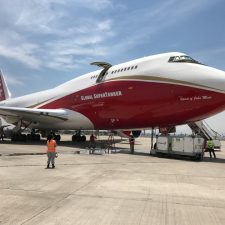On its first day in Chile the 747 SuperTanker made two drops on a wildfire but had to abort working on two other targets due to dense smoke over the fires.
After arriving in Santiago at sunrise on Wednesday the pilots went to a hotel to get the required rest before they were allowed to get back in the cockpit.
The other Global Supertanker personnel spent the rest of the morning and part of the afternoon unloading cargo, configuring the aircraft, meeting with local officials, and confirming logistics and operational procedures.
After all of that was accomplished it took off for its first mission, but while en route was diverted to drop on a different location where people were in imminent danger of being overrun by a fire. The huge aircraft works with a lead plane that scouts ahead of the air tanker and helps to determine where and how it can attack the fire safely and provide the best assistance for firefighters, and in some cases, residents, on the ground. In this case the pilot of the lead plane and the pilots in the air tanker found that the smoke and the visibility made it unsafe to attempt to drop on the fire.
After that decision was made the lead plane and the 747 reverted to the original target. The flight crew watched from a distance as the lead plane flew a “show me” run over the specific target area, indicating exactly what track to take and where to drop the water. Next, the air tanker made a dry run over the target, that is, without dropping water. This is frequently flown a little higher than the eventual water or retardant drop, to evaluate the effects of wind, convection over the fire, and terrain. Then after doing a large 360 it came around with the lead plane and made the actual drop — in this case, half of the 19,200-gallon load. A little later it made another pass and dropped the rest.
After those drops it returned to Santiago to reload with water. Due to the confined space and scattered parked airplanes on the military side of the airport that has been designated as the reload site, or “pit”, the 747 can’t simply taxi in, reload, and taxi out. A tug has to help it maneuver during either the in or out trip. This is a very unusual, almost unheard of, situation for an air tanker that is fighting forest fires. If a few of those parked aircraft were moved it would significantly reduce the turnaround time for the air tanker. It could come in to the dead end ramp, do a U-turn, park, reload, and taxi out.
After reloading it flew to another designated target, but again smoke was a serious issue. Both the 747 and the lead plane explored and examined several potential tracks to the intended target, but it was deemed unsafe to attempt to fly through the smoke, so the SuperTanker returned to Santiago and landed with its tanks full, without having to jettison the load before landing like most other air tankers are required to do.
Like all air tankers, the 747 can drop either water or long term fire retardant, the red slightly viscous liquid that is seen being dropped from most air tankers in North America, Australia, and Europe. Retardant is more effective than plain water. It actually chemically interferes with the combustion process, while the thickened nature of it allows the wet, ketchup-like substance to stick to surfaces rather than running off onto the ground. But long term fire retardant is not available in Santiago.
There are a number of products that can be mixed with plain water to enhance its effectiveness, usually at less than one percent concentration. The one being used by the SuperTanker is Pyrocool which is stored on the aircraft and added to the tanks as needed. Pyrocool has not been approved for use by the U.S. Forest Service, but has been used on marine fires and on the World Trade Center fire.
We corrected the article to reflect that Pyrocool has not been approved for use on wildland fires by the U.S. Forest Service, but has been used on some other types of fires within the United States including marine fires and the World Trade Center.


They should have mentioned that Pyrocool is an award winning environmentally friendly agent. Winner of the United States Environmental Protection Agency, Green Chemistry Challenge Award.
Hi my name is Rey and I would like to thank so much to the Walton family and foundation (Mr. Walton Heir and Mrs. Lucy Ana Walton) for helping the Chilean pleople fighting this disaster. Our family in Chile are deeply motivated for your cause and have no words to thank you for your help in sending this blessing bird from the sky to help those in need and give them a hope to keep going. Thank you always for your kindness
Rey Ayala and Family in Chile
Thanks for the good coverage. I’m sure in time the logistics of the water reload will be worked out.
Great information on how a mission works.
I can’t help but notice the subtle references to how rude Chilean journalists are “shouting” questions and acting like a “mob” upon government officials. They mistake their lack of professionalism and respect with assertiveness. On another note, I am glad that the Supertanker has been able to prove so many wrong and that in spite of its huge size and our small valleys it can make a difference.